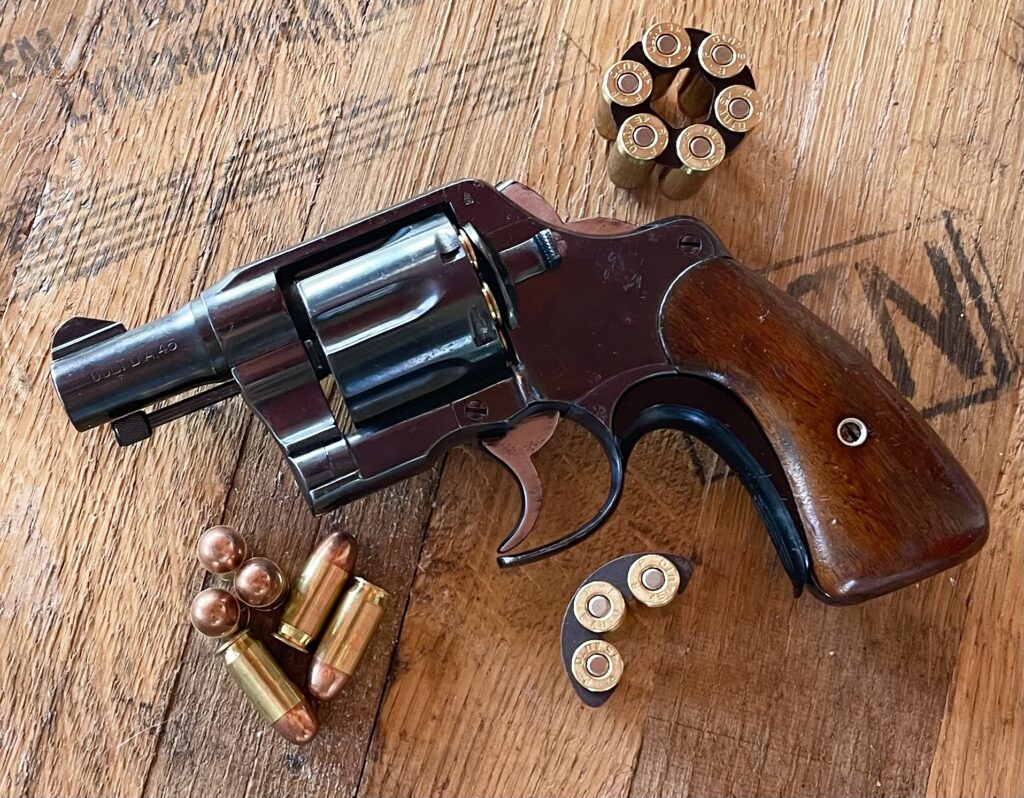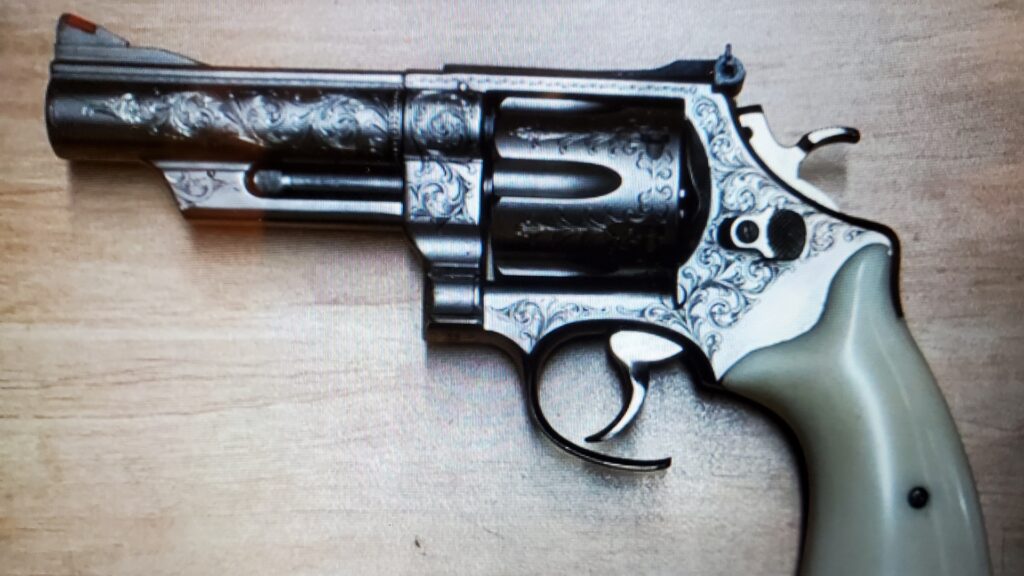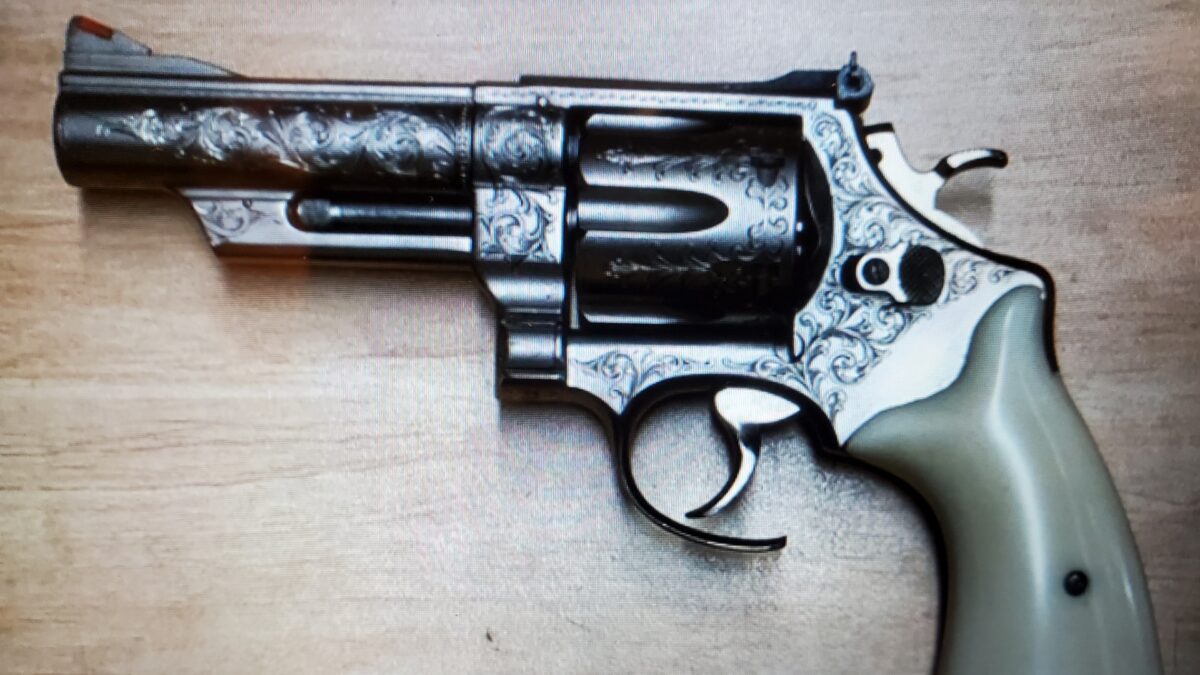In the wake of Steve Tracy’s excellent article on his Colt 1917 Fitz Special conversion, we thought it would be timely and appropriate to address a related, but lesser known, revolver modification known as the “Schlitz Special” conversion.
The Fitz
The most notable feature of the better known Fitz conversion is, of course, its cutaway trigger guard. This cutaway guard is frequently cited as an effort to improve trigger access, but has more recently been described as an aid to weapon retention (by preventing the trigger finger from becoming trapped and broken inside the guard in a disarm attempt).

There are other aspects of the Fitz conversion, to include bobbed hammers and abbreviated barrels and frames, but the Fitz’s cutaway trigger guard is the signature element of the design.
the Schlitz
It was this eye-catching feature which grabbed the attention of a pair of would-be firearms designers from the West Virginia/Kentucky border region. James “Bubba” Hatfield and Jasper McCoy were debating the merits of the Fitz conversion one evening, over a case of their favorite beer, when Hatfield suggested that Colt’s John Henry “Fitz” Fitzgerald got it all wrong with his unique trigger guard modification.
”I was thinkin’ that cuttin’ away the front part of the thing didn’t make no sense,” he told RevolverGuy in a recent phone interview, “cuz your finger don’t come at it from the front, see?”
Sensing our confusion, Hatfield’s business partner, McCoy, clarified for RevolverGuy, “What Bubba means, is that yer fingers is all behind the trigger guard when you hold the gun, so obviously yer trigger finger is comin’ at it from behind, so the back part is what needs hackin’ on.”
Annoyed at the interruption from his pal, Hatfield then blurted out, “Dang it Jasper! I was the one tellin’ the story before you butt in, so shet yer darned mouth!”
”It was my idea to begin with, Bubba!” replied an angry McCoy, before a commotion on the other end of the line interrupted the interview, and the phone went dead amidst the sounds of yelling, grunting, and a chair breaking.
follow up
A subsequent interview clarified more details about the history and intent of the design.
Hatfield explained to RevolverGuy that when a gun is holstered, the hand approaches it from behind, to obtain a grip on it, so it seemed appropriate to relieve the rear of the trigger guard to improve trigger access, since it was the first obstacle the finger would encounter on its way to the trigger.

With a case of Milwaukee-brewed hops fueling their imagination and creative energies, the dynamic duo decided to put their theory to test. A suitable candidate for the conversion was fetched from a tackle box in McCoy’s pickup truck (a prized, Rohm .22–“one of them fancy German guns”), and the budding gunsmiths commenced their work with an old hacksaw.
Unfortunately, the rusted blade broke almost right away, which caused a minor kerfluffle that delayed the work until the following day, when both men had nursed their wounds with ice and more beer.
But the power of the idea was “strong as the smell of momma’s feet,” and the pair resumed their task the next evening with a fresh case and a replacement hacksaw, borrowed from a neighbor. Within a few minutes, the first Schlitz prototype had been completed and was ready for testing.
shots fired
Since it was McCoy’s gun, he was given the honors of being the first to fire the conversion. After firing a full cylinder from the mutilated modified revolver (an impressive feat, in itself, from a Rohm), he determined the unique cutaway guard was a success, since his trigger finger, “didn’t once get hung up on the back.”
Further testing from Hatfield produced similar results, and the pair found that as the night wore on (and their case of liquid creativity diminished), they were able to fire the gun “with amazing speed,” like never before. Additionally, the accuracy of the modified arm seemed unmolested by the conversion, as the partners were able to place accurate hits on a tin roof, a barn door, a pickup truck window (McCoy’s, which started another fight), and an old milking can (which may have actually just been a ricochet off the heavy timber of a roof beam).
Moving targets proved harder to hit though, as the old milking cow that went with the can escaped, unscathed.
what’s next
Buoyed by their success, Bubba and Jasper have begun to offer their unique conversion to the shooting community, but admit sales have been slow since they hung out their shingle (technically, a scrap of cardboard from a case of Schlitz).
They’re confident, though, that the novel idea will catch on, and report that they’re in conversations with a “major manufacturer” who’s interested in purchasing the rights to the unique design.
Hatfield and McCoy are tight-lipped about identifying the mystery client, and we have to admit we’re a bit stumped here at RevolverGuy. With the breakup of Freedom Group, there’s no obvious sucker suspect on the list, but we’ll continue our investigation and will provide updates in these pages.


Great job, Mike. This is a great article about a rather obscure subject that I wouldn’t have known about (and still don’t). Very fitting for this fine day dedicated to learning.
By the way, The Firearms Blog just did a YouTube video the other day where James Reeves compared a Rock Island Armory M206 to Busch Lite. Do I sense a category of “beer revolvers” emerging?
Hmmm. That may require some research, Greyson. Hey, Bartender . . .
I am seriously considering spending the large coin on this conversion for my LCR. Looks like exactly what I have been missing in my training/tools selection for self de-fence.
It should be easy to engrave the polymer sub frame. I’d do it.
Lance, let me know how your conversion on the LCR goes. I may borrow a hacksaw and try it on my own LCR. As I purse carry, the open trigger guard in the rear should assist me in a faster draw from the purse ready to shoot.
WGJ
After you’ve blasted the bad guy, you could even hook the guard on your shoulder strap and hang it there, as a deterrent to the the other goblins. Call it a tactical fashion accessory!
I’m still laughing . . . Schlitz !! That’s right down there with PBR and Old Milwaukee. I do hope that Custom Gunsmith, Jo Jo The Gun Plumber, might avoid inspiration from Henry ‘Hack’ Saw and Bo Dremel.
Wait . . . I just left my engraved SAA at their shop, for a repair. Are you saying that I should be worried?
Uh, well . . I would be !
Good one Mike! Your as ornery as my Sister. She got me every year. She sure loved April Fool Jokes.
Think I saw some of their work in a pawn shop yesterday. Spied a U.S. Firearms SAA 4&3/4 .45 for about half of retail. Had my interest until the sales lady got it out of the case saying it had an issue. Those boys you were writing about had tried to lower the front sight with some kind of industrial strength grinder.
They must have had an oops moment, there are gouges all around the front sight some almost creating ports.
Wait, that might be intentional. Those guys are geniuses of the gun.
Tony, those are carefully placed windage offset marks. Kinda like tics on a scope reticle, but for fixed sights. Very sophisticated tech, there.
For a brief moment you had me Mike. Then I realized that it is April 1st. Good on ya.
Hooray! I hooked one! 😁
My favorite part was describing a Rohm as “one of them fancy German guns.” I remember seeing them in the display case at my local Kmart around 1970 (yes, Kmart used to sell revolvers). They were German, and they were fancy, if you’re dazzled by pot metal, so these guys got something right.
“Saturday Night Specials?”
No, “Blue Light Specials!”
I hear the cow went on to kick over a lantern in Grandma Leary’s shed!
Haha!! Too funny!!
For those of you who don’t remember Scout campfire songs:
Mrs. O’Leary’s Cow
The Curious Case of Sidd Finch. Ya had me for a bit.
Haha! Jack, I didn’t know the Sidd Finch story until you mentioned it, but sure got a chuckle out of it when I looked it up!
It’s become an April Fool’s tradition here at RevolverGuy. After doing it the past several years, I didn’t want to miss one.
I think this is all a bunch of hooey. Anybody with less than a half a case of ‘inspiration’ in them would know you don’t use a hack saw on a trigger guard. A sawz-all works faster and makes a cleaner cut. Easier to use on the barrel, too, if you want it shortened.
Ace, would that be the gas powered version, with the pull starter?
Mine has a reciprocating pulley attachment; just tie it to the dog’s tail and get her excited.
She’s also a meteorologist. If I want to know if it’s raining, I send her outside and see if she comes back in wet.
And I bet she’s smarter than all those men in Washington D.C., combined!
Late to the party, but as a retired mechanical designer, I couldn’t help but comment to say thank you for showing the genius of these fine gentlemen. I can envision a second iteration with a spring loaded toggle on the trigger, allowing your finger (or any random object) to slip past the trigger and ready to fire.
But an even more functional variation would be to combine both designs, removing both the front and rear of the trigger guard. The remaining center portion could be attached to the bottom of the trigger with JB Weld, and we’re good to go!
I’ll have to test this out. My wife would have a Shlitz Fitz if I did this to her revolver!
Hahaha! Some people just aren’t progressive, you know.